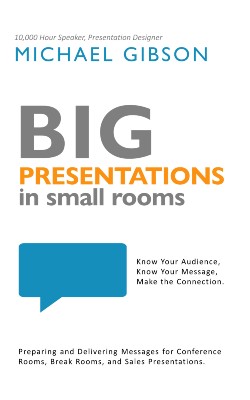Presentation Blockers: An Unfortunate Reality
“…And suddenly my presentation was interrupted by…”
Without hearing the rest of the sentence, you can sense the frustration. They wanted to send a message, but something got in the way—a presentation blocker.
Presentation blockers are an unfortunate reality. Those who respond wisely are impressive. Those who become distracted or defensive make bad impressions. The stakes are high.
Your message is important. You want to ensure that it meets needs in ways that build support for your idea or your work. You do all that is in your control to develop that message… but you are not in control of everything. And some out-of-control elements make it difficult to reach your goals. What then?

Recently, I was facilitating a training for Lead Workers, the topic was communication. It was a great group, and the conversations were a treasure chest of observations. We simplified the communication process to three key elements: observation, consideration, and transmission.
These correlate to the three elements of the Big Presentations mantra: Know your audience. Know your message. Make the connection. How do you know your audience? You are observant. How do you know your message? Through consideration. How do you make the connection? By transmitting your message.
Toward the end of the class, we addressed blockers. What things can block observation? What things can block consideration? What things could block transmission? This is where the discussion became intensely focused. This is where we went from theory to application. Application will always be more difficult than theory. I am thankful that the application conversations happened. It is easy to oversimplify communications lessons. When this happens, it creates frustration when it is time to make the application.
In August of 1987, the Associated Press published an article containing what would become a legendary quote. The article focused on a boxing match planned for October in Atlantic City, New Jersey.
Tyrell Biggs says he has a plan to beat heavyweight champion, Mike Tyson. But the man they call “Iron Mike” is not impressed.
“Everybody has plans until they get hit for the first time,” Tyson said.
Do you remember the classic Geico commercial with Dikembe Mutombo, where he runs around blocking various attempts to toss an object into a goal? A businessman tosses a crumpled paper at a wastebasket, and there he is—swatting it down, wagging his finger, and saying with a chuckle, “Not in my house!”
And the businessman is bewildered. What just happened? And what do I do now?
Any discussion of applied communication skills is incomplete if we don’t talk about the obstacles, the punches in the face, the shot blockers.
So, what do we do?
Let’s address the three elements, the blockers, and some ideas regarding how to address them.
Presentation Blocker 1: Observation Blockers
When asked to list things that block observation, participants said:
Absence
Tunnel Vision
Distractions
How do you overcome these blockers? Here are some ideas:
To avoid the blocker of absence, be present. This sounds overly obvious, but it can be difficult to apply. We might be so busy that it is difficult to show up. We might be juggling so many responsibilities that it is hard to watch everything that is going on. There might be reasons for the absence. Try to overcome those situations rather than using them as an excuse. And encourage others to function in the same way… if they need to be present, invite and encourage them to show up!

To address tunnel vision, first, acknowledge that it is happening. Then be open to having others tap you on the shoulder and shake you out of it. It is tempting to be defensive when we are held accountable. Fight that temptation and be grateful for the chance to refocus on the issue at hand. And when appropriate, offer the same service to others.
The third observation blocker is distraction. This is the opposite of tunnel vision. With distraction, your attention is all over the place. Every movement, sound, or change can capture you and keep you from investing in communication. It is difficult to observe a specific thing because you are trying to observe everything. To overcome this blocker, be aware of your own distractions. Use self-discipline to continually bring your attention back to the audience, the message, and the connection. Know that you do not need to speak everything that crosses your mind. Filter distractions mentally and verbally. Stay focused! It is helpful if you have a trusted friend and coworker who can give you feedback or gently pull your attention back to where it needs to be.
Whether you are dealing with absence, tunnel vision, or distractions, be willing to receive help and provide help to overcome these observation blockers.
Presentation Blocker 2: Consideration Blockers
When asked what blocks consideration, participants listed the following:
Pre-conceived notions
Overcommitment
Lack of cultural awareness
How do you overcome these blockers? Here are some ideas:
To overcome the blocker of pre-conceived notions, be willing to listen and to think about new things and new understandings. Be humble enough to learn about alternative approaches and recent research. Be willing to question the status quo and allow others to do the same. It does not require change, but it does require humble listening, a determination to understand, and a willingness to change when needed. Do these things and invite others to do them, as well.
The second obstacle is overcommitment. This is a hard one to address. You might feel helpless to change the amount of work required of you, but you can change the way you think about that work and the other people involved in that work. Often the time required for listening and considering is a matter of seconds or minutes, not hours or days. And the relational investment can pay off in ways that save time in the future.

The third obstacle to consideration is a lack of cultural awareness. This can hurt us because we don’t know what we don’t’ know… and so we cannot make the needed adjustments. Humble curiosity is the way to overcome this blocker. When something seems out of the ordinary, there might be a good reason for that behavior. If someone seems to want to connect but they do something that is considered rude in our culture, it could simply be a misunderstanding. The other person could be showing you respect according to the rules of a different culture. Cultural awareness informs our observations and leads to higher quality considerations.
Presentation Blocker 3: Transmission Blockers
When asked what blocks transmission, participants listed the following:
Fear and Intimidation
Lack of Skill
Distracted Audiences
How do you overcome these blockers? Here are some ideas:
Fear and intimidation are difficult to overcome because they are mindset issues. Even when you know that the fear or intimidation are unwarranted, it can be difficult to turn off the voices in your mind. What to do? The simple answer is this. Allow other voices to be heard. This could be your own voice countering the fear with the confidence of proper preparation and practice, or it could be the voice of other people who believe in you and can speak encouragement to you. In extreme cases, counseling might be needed to help overcome the fear. It is helpful to know that your fear and intimidation are not noticeable unless your voice is shaking, or your hands are trembling. When you can speak clearly and stand tall, your fears need not distract from your message.

Lack of skill is another transmission blocker. There are two concepts that will help you get past this hurdle: knowledge and application.
Seek knowledge. There are great resources to help you with this, there is much knowledge available.
Pursue opportunities to apply the knowledge. The more you learn and apply, the better you will be. And the more confident you will feel! The voices of fear and intimidation will fade as your skill grows.
The third obstacle to transmission is audience distraction. There is a wide variety of things that can distract the audience. Some are external, like noises, smells, temperatures, and being crowded. Some are internal, like emotions, mental planning, or having a spoken word remind the listener of an old memory or a task that needs to be accomplished.
Some distractions might be worthy of discussion. Often those things can be recorded and discussed at another time. Other distractions might need to be addressed so that we can refocus. A quick acknowledgement followed by a refocusing statement is helpful in those situations.
Fear and intimidation, lack of skill, and audience distraction can make transmission difficult. But you can overcome these obstacles with patient determination and a willingness to learn and apply.
Presentation Blocker Principle: Focused Adaptation
Whether you are facing observation, consideration, or transmission blockers, there are two big ideas that can help us: One is focus and the other is adaptation.
What is the focus?
When overcoming blockers, keep your focus on the connection. How can you connect the audience to the message? The knowledge of your audience is for this purpose. The crafting of your message is for this purpose. And the way you address blockers should retain the same purpose. When distractions occur, stay focused. When a punch is taken or a shot is blocked, stay focused. Make the connection.
What are the options?
With the focus in mind, consider possible adaptations, and then filter them. Know your boundaries. The boundaries are determined by time limits, authority, and rapport. Think TAR when considering your options: time, authority, rapport.

Time: When you are delivering a big presentation or simply delivering instructions to your team, time matters. You have limits in the form of predefined speaking time, product deadlines, lunch breaks, 5 o’clock bells, etc. Use wisdom to ensure that your response is not undermined by your time limitations.
Authority: Know your place! When addressing blockers ensure that you are functioning from the center of your place. In most situations, you should not be pushing the boundaries with your responses. This can create an additional distraction and additional push-back from the audience members. This is true whether you are threatening the authority of those over you or refusing to uphold the responsibilities of the authority that has been given to you! Know when to adapt by submission and when to adapt by assertion. Your adaptations should be appropriate for your place in the organization.
Rapport: Rapport is an ideal relational reality. It is used to describe a relationship built on mutual trust or affinity. Pursue both. Be trustworthy. Be likable. You cannot always achieve both when dealing with blockers, but you should make it the ideal you shoot for. When you have both, your options for adaptation are more numerous, because your audience members already trust you. They already like you. Of course, you want to work to maintain that rapport, but you can relax a little more than you could if rapport has yet to be established or if rapport has been damaged.
If you are characterized by honoring time limits and responding in ways that are appropriate to your level of authority, that will help establish the trust side of rapport. If you are friendly, kind, and helpful, that will help establish the affinity side of rapport.
Presentation Blockers: You Can Overcome
You know your audience. You know your message. You are determined to make the connection. Even when punches come, and blockers are present.
You are focused. You adapt.
And as you develop a reputation for being wise in your communications, you will be increasingly able to deliver Big Presentations in Small Rooms.
Want to know more? Keep reading the blog!
Do you prefer to listen? Check out The Big Presentations Podcast!
Want to know even more? Order the book Big Presentations in Small Rooms!




